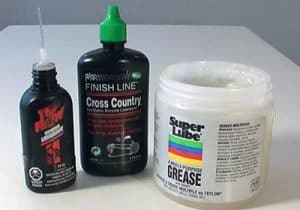The benefits of bike chain lubrication
Bike chains are entirely made up of moving parts that will rub against each other creating friction and eventually wear and tear. Lubricating these parts is the only way to reduce these actions ensuring that your bike chain lasts longer on the road. The links on a road bike chain are likely to break with strain due to heat and pressure. Lubrication not only makes it easier for them to move against each other but also cools them down. The wear and tear are reduced significantly making sure that you do not end up with a broken chain at any time of the day. Lubrication is not a choice no matter the quality of the chain you are working with.
The kind of lube you use is, however, crucial. There are many options in the market with people asking questions even about options. It is advised that you work with the best when it comes to your chains for the purpose of giving optimal care for the same. But also be cautious, don’t lube without knowing how much you should use. Bike chains are irreparable, and the effort of doing so will not yield any lasting results. A broken chain should be simply replaced so as to maintain the quality of the ride as well as the safety. A broken chain can easily cause accidents especially for bikes that depend on the chain for braking.
What are the best oils to use?
Light oils
Light oils come in handy when you need lubrication to penetrate the deepest of crevices in your bike chain. These are mostly applied by syringes for maximum penetration. It is applied by cranking the pedal backward for proper distribution. The best, in this case, are Tri-Flow and Phil Wood Tenacious Oil. These will also work best in a wide range of weather conditions without degrading in any way. The fact that dust does not stick on it makes it ideal. It will, however, be slightly limited in very wet conditions where grease is the best solution.
No products found.
Tri-Flow Superior Lubricant Drip Bottle (6 oz)
Grease
This is one of the best options in Mediterranean weather. These areas are often rainy and humid. It is recommended that you use a solvent to lighten it helping it penetrate the chain links better. Thick grease will go as far as it is applied which makes it limiting despite the fact that it is one of the best lubricants. The biggest issue with grease is that it will pick dust as you ride. The more dirt it picks, the more grinding you will experience. This waters down the whole idea of lubricating to reduce friction. This kind of lubricant will need to be changed every once in a while when the weather becomes dry. You can also replace it when the weather changes to lighter options.
Wax-based lubricants
Wax is rated as one of the best choices in the market for some reason. This is as long as you will figure out the kinks of applying it. Hot melted wax can be tricky to use at this point but is full of benefits. The wax will flake after use which means that you will not have to go to the trouble of de-greasing your bike anytime. The wax will also not attract any dust which is an added advantage. It is the best option in dry conditions and can last on the chain for months.
Finish Line Ceramic Wax Bicycle Chain Lube

Sprays
This may yet be the best kind of lubricant when it comes to the application but the worst in benefits. Sprays face the challenge of being too thin to work on bikes for longer than a few days. One of the problems is that it is made lighter using solvents that act more like degreasers as opposed to lubricators. It will also easily wash away in most weather conditions. WD40 is one of these and is not recommended for high-performance bikes. It will even go to the extent of de-greasing manufacturer-based lubricants on the bike speeding up friction and rusting.
Substitute for bike chain Oils
It is common for people to look for cheaper ways to solve everyday solutions. We do not expect it to be any different when it comes to bike oils. People have tried quite some options; most of which will work but not perfectly. Bikes are also demanding when it comes to the quality of maintenance you offer. Substitutes will either be too thin, too greasy, attract a lot of dust, last for a very short time, or simply cause more problems.
Can you use Olive oil?
Olive oil is usable but with some side effects. It will work when it comes to keeping the rust away but will easily attract dust to the links of the chain. It is also absent of graphite which is one of the most critical components of any lubricant causing it to polymerize. Vegetable oils will also have a similar effect. The fact that they will solidify in cold weather making them a greasy mess especially when dust hits the chain. A chain needs to look good even with lubricants on it. The fact that these oils will degenerate may end up costing you more than you want in the long run.
Are substitutes worth it?

Let’s face it; lubricants are cheap, and so are chains. They will cost somewhat less than $10 which gives no excuse for one to use substitutes. These lubricants will be the best option for your bike compared to any replacement which may cost more. People will create their hybrid lubricants but will still cost more than the real thing. The point is that they are not worth it. Know whether the alternatives to bike chain lubricants are really worthy to use.
What is WD40 and can it be used?
This is a spray-based lubricant that is common in the market. It is advised that you steer clear of spray-based lubricants. WD40 has a tendency to last for a very short time on the bike chain as well as de-grease the bike chain. There are much better options as mentioned earlier that you can use with a good price tag.
WD-40 Multi-Use Product (with SMART STRAW SPRAYS)
In conclusion, it is wise for you to know when to lubricate and what to lubricate with. You also need to know when to change the bike. Lubrication does not stop wear and tear entirely. It will simply slow it down. The best lubricants will be the ones that will slow it most.



Helpful article that had me taking home the wax lubricant instead of sticking with the WD-40, which, thanks to you, I won’t be using it again for bike lubricant. Reread your article, a few typos in bad spots, don’t trust grammar apps 100 percent. Try edit-gr/sp check-edit and post. Thanks!
Thanks for your feedback, Joseph!
Great article – What about a bike chain specific dry lube? WD-40 makes a specific bike chain product both wet and dry, which would you use? (We have Pedego electric bikes, which should not make a difference, but just to give you information.) Thanks
Hi KenG,
Thanks for your feedback 🙂
I will suggest you to use the WD-40 as the dry lube for your electric bike as well.
Best regards
Kawser Ahmed